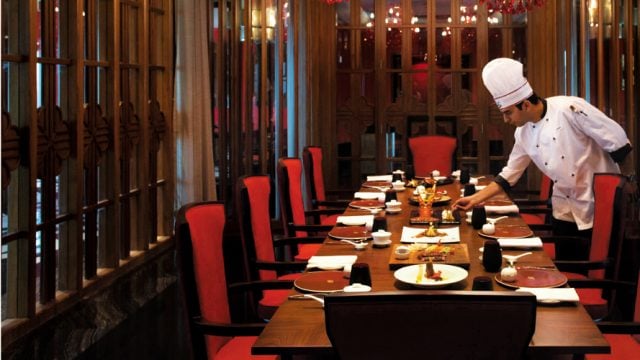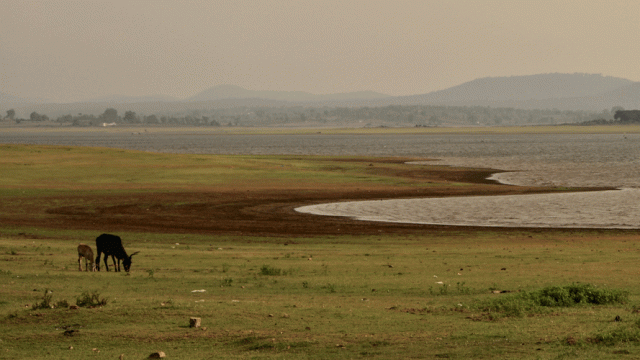Spread across 285 acres of rich, green and incredibly biodiverse land, the Parambikulam Wildlife Sanctuary
The Parambikulam Wildlife Sanctuary brought together the forest reserve areas of Sungam and Parambikulam in the 1960s. These reserves were heavily exploited for their vast reserves of timber in the early 20th century. However, in the 1950s, the government of the newly independent state of India stepped in to abolish the tramways established by the British for easier transport of teak, to dissolve the teak plantations and to prohibit the felling of the trees. Nowadays it is famous as a highly protected, bio-diverse reserve.
The main attractions here, for which most tourists make the long trip to the sanctuary, are the big cats – leopards and tigers. Not everyone gets a glimpse of these glorious jungle cats, although, on rare occasions, they are known to pop by the small coffee shop near the Parambikulam bus stand to reveal themselves to the loud and colourful human beings. But for those who are spared this hair-raising and highly adrenaline-pumping experience that it can be, there are many other mammals – including bears, elephants, macaques and flying squirrels.
The sanctuary also attracts over 120 kinds of butterflies, of which 34 species are endemic to the region, and 134 rare and 18 endangered species of birds. Neem, teak and sandalwood trees populate most of the forests. The oldest tree here is the majestic Kannimara Teak, believed to be 450 years old. This abundant and thriving population of flora and fauna in the sanctuary coexists peacefully with the four indigenous tribes: Kadar, Malasar, Mala Malasar and Muduvar.

Parambikulam Wildlife Sanctuary lies south of the Palghat Gap in the Western Ghats, between the Anamalai and Nelliyampathy Hills, at an altitude ranging between 980 and 4,600ft. The sanctuary has no direct roads connecting it with towns in Kerala, and must be accessed from Pollachi in Tamil Nadu. There is a certain amount of grunt work involved in getting here, as tourists will have to negotiate with the Forest Departments of both Kerala and Tamil Nadu. The latter manage the Indira Gandhi National Park at Anamalai (Entry ₹ 15), which has to be navigated to get to Parambikulam. The Annapadi Checkpost, 10km from the Anamalai Sanctuary, marks the transition from Tamil Nadu to Kerala, and the beginning of the Parambikulam reserve area.
Things to See & Do
Parambikulam Wildlife Sanctuary
Tourism at the sanctuary is carefully monitored and visitors are only allowed inside with an experienced forest guide. Eco-tourism at Parambikulam incluces trekking, night-stays, camps and nature-education trails. All of these are organised by the Parambikulam Tiger Reserve Sanctuary. Contact the Forest Information/ Wildlife Interpretation Centre at Annapadi for guides. It is a good idea to get there as early as possible, as animals are most active at this time of the day. One should also ideally come in a vehicle, as moving around inside the park without one is difficult. It is possible to stay within the sanctuary. Parambikulam offers a larger number of accommodation options, which are nonetheless basic. Indeed, staying here for a night can be quite a wonderful experience; wild animals come out to drink on the far side of the lake in the evenings. As night falls over the forests, a sort of stillness envelops the sanctuary, disturbed only by the cries of owls and the occasional roar of a tiger. On cold winter nights especially, the sanctuary’s many hotels offer the pleasurable experience of sitting by a fire and feasting on simple, but delicious and hot food.

For day trips, however, please remember that the gates close at 6.00pm, after which no vehicles are permitted in or out of the sanctuary. Private tour companies also arrange for trips and tours to the sanctuary.
Entry ₹ 170 Timings 7.00am–6.00pm Vehicles ₹ 25–80 Cell 09442201690 Email [email protected], [email protected] parambikulam.org/
Kannimara Teak
One of the oldest and largest teak trees in the world, this 450-year-old tree is 6.57m wide and 48.5m high. This tree is the remnant of wild teak which grew in the area before the teak plantations came up. The Government of India bestowed the Mahavriksha Puraskar upon the Kannimara Teak in 1994–95, establishing it as a healthy, historical and valuable tree. Situated 7km from Thunakkadavu, the route itself offers plenty of sights and sounds. There is a vayal on the way, where herbivores such as deer, sambar and gaur can be usually seen in large numbers.
Trekking Trails
The Parambikulam Sanctuary, with its hilly terrain, peaks and valleys, offers a large number of trekking trails for the wildlife enthusiast. Peaks like Karimala Gopuram (4,718ft) and Vengoli Peak (3,675ft) are favourites with visitors and not very difficult to climb. Treks also afford sightings of highly endangered animals like the Nilgiri tahr, though it is more likely to spot tahr droppings.
Seven eco-development committees have been set up by the Forest Department in Parambikulam, to bring the benefits of tourism to the indigenous tribal communities. Visitors must get permission to trek from the Forest Information Centre at Annapadi, and hire a tribal guide; one guide can accompany groups of up to five people, while larger groups will need to hire more guides. Fees range from ₹ 50 to ₹ 100 per head depending on how difficult the trek is. Treks through selected routes in the forest can also be arranged, with overnight stays in machans and watchtowers. Birders will love these treks, as they offer the opportunity to spot up to 268 avian species.
Dams and Reservoirs
The three dams – Parambikulam, Thunakkadavu and Peruvaripallam – are all located inside the sanctuary on the Parambiar river. Rowboats can be hired for boating at Thunakkadavu and Parambikulam. Mugger crocodiles are often spotted in the water or sunning themselves on the banks.
Boating fee ₹ 100 per hour
Where to Stay
The day’s activities in Parambikulam come to a standstill by 6.00pm, when the chains are drawn across key points on the roads and all traffic is halted. The pathways belong to fireflies and other creatures of the night. This is the time to relax on the lakeshore with steaming cups of hot tea. Forest Department Inspection Bungalow (Information Centre, Annapady Cell: 094422 01690/ 91; Tariff: ₹ 900) at Thunakkadavu, or the newer treetop huts, both of which overlook the reservoir. The bungalow has a cook and attached bathrooms. Hot water is provided on request.
There are two tree-top huts with attached baths, one each at Thunakkadavu (Tariff: ₹ 3,850– 5,500 per couple) and Parambikulam (Tariff: ₹ 2,750–3,300 per couple). Both accommodate one family at a time, and must be There is also the Bison Valley Lodge (Tariff: ₹ 200 per person at Parambikulam, with three double rooms, each with their own attached bathrooms.
A special stay option is the Vettikunnu Island Nest Cottages (Tariff: ₹ 8,250–8,800) on the Parambikulam Reservoir, accessible only by boat. Stay is in the old wireless station here, which accommodates five people. The tariff includes boat charges and guide fees. Food must be carried in from Parambikulam, though you can also cook food at Vettikunnu.
All the above may be reserved in advance through the Information Centre
Another option is the PWD Inspection Bungalow (Tel: 04253277223; Tariff: ₹ 300) at Thunnakadavu. The five rooms are comparatively well furnished, with attached bathrooms, watchtowers and a cook-cum-caretaker, though you can get meals at the several restaurants and canteens in the vicinity.
Where to Eat
Most hotels in Parambikulam have restaurants, canteens or kitchens. At some places, like the old wireless station on Vettikunnu Island, on the Parambikulam Reservoir, you must cook your own food. Other than these, there are a few local eateries and restaurants which offer basic South Indian food like idlis and dosas for breakfast, and spicy fish fry and chicken curry for lunch and dinner. The Honey Comb Restaurant at the Treetop Huts offers excellent fare as well.
|
Fast Facts |
|
When to go The sanctuary closes during the summer months from May to September because of the danger of forest fires; specific dates are announced by the Forest Department a few days prior to closing. It is also advisable to avoid coming here during the monsoons |
|
Wildlife Offices |
|
Forest Information Centre |
|
Annapadi (HQ), |
|
Wild Life Warden District Palakkad Location Parambikulam lies within the Western Ghats in the southeastern parts of Palakkad District. It is contiguous with the Anamalai Sanctuary across the state border, in Tamil Nadu. To get to Parambikulam, one has to travel to Tamil Nadu first and then enter the sanctuary through the Anamalai Sanctuary Distance 267km NE of Kochi Route from Kochi NH47A and NH47 to Palakkad via Aluva, Angamali, Chalakudi, Thrissur, Vadakkancherri and Alathur; state roads to Annapadi Checkpost via Sethumadai and Top Slip |
|
Getting There |
|
Air Nearest Airport: Peelmedu Aorport, Coimbatore (119km/ 2.5hrs). Prepaid taxis to Parambikulam (Cell: 09976494000) will cost between ₹ 2,500 to ₹ 3,700 |
|
Rail Nearest Railhead: Coimbatore Junction is connected daily to Thiruvananthapuram by the Cape Mumbai, Kochuveli, Kanyakumari, Kerala and Trivandrum Expresses; to Ernakulam by Kochuveli, Sabari, Ernakulam, Kanyakumari, Alleppey Expresses; to Bengaluru by the Lokmanya TT and Bangalore Expresses, to Chennai by Nilgiri, Chennai and Cheran Expresses; to Mumbai by the Cape Mumbai and Lokmanya TT expresses and to Delhi by the Kerala Express |
|
Road From Palakkad, cross the Palghat Gap and drive 47km to Pollachi, Tamil Nadu. Turn right towards the Anamalai Sanctuary entrance at Sethumadai Checkpost (30km away). Parambikulam is 30km ahead via Top Slip and the Annapadi Checkpost |
|
Bus Two public transport bus services, run by the TNSTC, run from Pollachi, starting at 6:15am and 3:15pm, daily |
Kerala
Manasi Saxena
OT Getaway Guides





